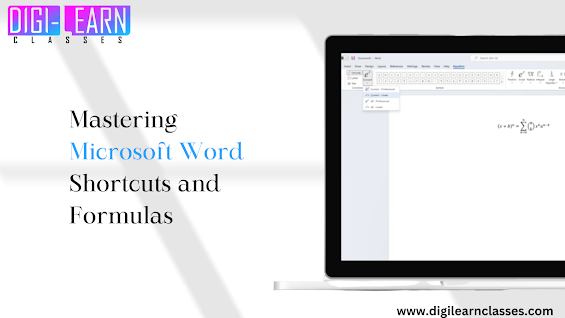Microsoft Word Formulas | Shortcut keys | Word
Mastering Microsoft Word Shortcuts and Formulas: Boost Your Productivity
Introduction
Microsoft Word is a powerful word processing software that has been a staple in offices, schools, and homes for decades. While it offers a plethora of features to make document creation and editing easy, many users are unaware of the time-saving benefits of keyboard shortcuts and formulas. In this article, we will delve into the world of Microsoft Word shortcuts and formulas, unlocking their potential to enhance your productivity and efficiency.
Part I: Keyboard Shortcuts
1. Basic Text Formatting Shortcuts
· Ctrl+B: Bold
· Ctrl+I: Italicize
· Ctrl+U: Underline
· Ctrl+=: Subscript
· Ctrl+Shift++: Superscript
These basic formatting shortcuts are essential for quick text formatting. Whether you're emphasizing a word or creating a chemical formula, these shortcuts save valuable time.
2. Navigation Shortcuts
·
Ctrl+Right Arrow: Move the cursor to the
beginning of the next word.
·
Ctrl+Left Arrow: Move the cursor to the
beginning of the previous word.
·
Ctrl+Up Arrow: Move the cursor to the beginning
of the previous paragraph.
·
Ctrl+Down Arrow: Move the cursor to the
beginning of the next paragraph.
Efficiently navigate through your document using these shortcuts. You'll be amazed at how much time you can save by avoiding constant mouse clicks and scrolls.
3. Selecting Text
·
Shift+Arrow Keys: Select text character by
character.
·
Ctrl+Shift+Arrow Keys: Select text word by word.
·
Ctrl+Shift+Home: Select from the cursor to the
beginning of the document.
·
Ctrl+Shift+End: Select from the cursor to the
end of the document.
Precisely selecting text is essential for formatting, editing, or copying content. These shortcuts make the process a breeze.
4. Copy, Cut, and Paste
·
Ctrl+C: Copy
·
Ctrl+X: Cut
·
Ctrl+V: Paste
·
Ctrl+Z: Undo
·
Ctrl+Y: Redo
Mastering these shortcuts is a fundamental step in boosting your Word productivity. Avoid fumbling with menus and use these commands seamlessly.
5. Formatting Paragraphs
·
Ctrl+L: Left-align text
·
Ctrl+E: Center-align text
·
Ctrl+R: Right-align text
·
Ctrl+J: Justify text
Efficiently format your paragraphs using these shortcuts to give your documents a polished look.
Part II: Formulas and Functions
1. AutoCorrect and AutoText
Microsoft Word provides a feature called AutoCorrect that can save you a lot of time. You can create custom shortcuts that automatically expand into longer phrases or sentences. For example, you could set up "addr" to expand into your full mailing address.
- To set up AutoCorrect, go to File > Options > Proofing > AutoCorrect Options. Here, you can add your shortcuts and their corresponding expansions.
2. Word Formulas
Microsoft Word also allows you to create simple calculations within your documents. Here's how:
·
Place your cursor where you want the result.
·
Press Ctrl+F9 to insert a pair of field braces:
{ }.
·
Inside the braces, type your calculation using
field codes. For example, to add two numbers, you would use {=2+2}.
Word will automatically calculate the result and display it. This is handy for quick calculations without the need for a calculator or spreadsheet.
3. Tables and Excel Integration
Word is often used in conjunction with Microsoft Excel. You can embed Excel spreadsheets in Word documents and perform calculations within them. To do this:
·
Insert an Excel spreadsheet by going to Insert
> Table > Excel Spreadsheet.
·
Enter your data and calculations in Excel.
·
You can also link Excel data to Word, so changes
in the Excel file are reflected in your Word document.
This integration is powerful for complex calculations and data presentation.
4. Mail Merge Formulas
If you're creating documents with personalized content, such as letters or mailing labels, Mail Merge is a fantastic tool. It allows you to merge data from an Excel spreadsheet or another data source into your Word document.
·
Go to Mailings > Start Mail Merge >
Letters (or other document type).
·
Select Recipients and choose your data source.
·
Insert merge fields where needed by clicking
Insert Merge Field.
· Complete the merge, and Word will generate individual documents based on your data.
This is a time-saver
when creating bulk documents with varying content.
Conclusion
Mastering Microsoft Word shortcuts and formulas can significantly enhance your productivity. Whether you're a student, professional, or simply use Word for personal tasks, these tools can save you time and effort. Incorporate these shortcuts into your workflow, and explore the potential of Word's formula and function capabilities to make your document creation and editing tasks smoother and more efficient. With practice, you'll become a Word power user, completing tasks in record time and producing documents with precision.


.png)
.png)
Comments
Post a Comment